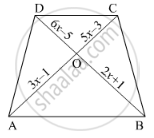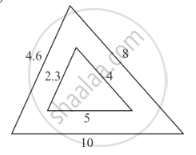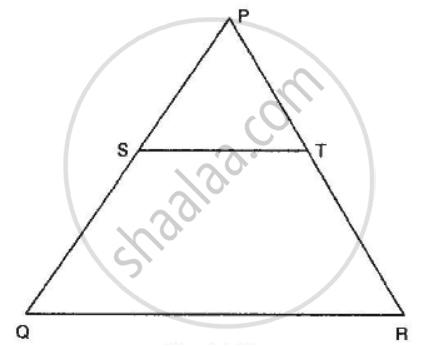Advertisements
Advertisements
प्रश्न
In ∆ABC, ∠ABC = 135°. Prove that AC2 = AB2 + BC2 + 4 ar (∆ABC)
उत्तर
We have the following figure.

Let Draw an altitude AD on Extended BC
In ∆ADC, ∠D = 90°
Therefore, by Pythagoras theorem, we have
`AC^2=AD^2+DC^2`
`AC^2=AD^2+(DB+BC)^2`
`AC^2=AD^2+DB^2+BC^2+2.BC.BD` ...(i)
In ΔADB, ∠D = 90°
⇒ `AD^2 + BD^2 = AB^2`
By substituting values of equation (i)
⇒`AD^2+DB^2+BC^2+2.BC.BD = AC^2`
⇒`AB^2 + BC^2 + 2BD.BC = AC^2`
As in ΔADB, ∠DAB = 45°
⇒ AD = DB (Opposite sides are equal)
⇒`AB^2+BC^2+2.BC.BD = AC^2`
⇒`AB^2+BC^2+2.BC.AD = AC^2`
⇒`AB^2+BC^2 + 4 xx 2/4 xx AD xx BC= AC^2`
∴ `1/2 xx AD xx BC = ar(ΔABC)`
⇒ `AC^2 = AB^2 + BC^2 + 4 ar (∆ABC)`
APPEARS IN
संबंधित प्रश्न
In the below figure, If AB || CD, find the value of x.

In each of the following figures, you find who triangles. Indicate whether the triangles are similar. Give reasons in support of your answer.

In the given figure, S and T are points on the sides PQ and PR respectively of ∆PQR such that PT = 2 cm, TR = 4 cm and ST is parallel to QR. Find the ratio of the areas of ∆PST and ∆PQR.

XY is drawn parallel to the base BC of a ∆ABC cutting AB at X and AC at Y. If AB = 4 BX and YC = 2 cm, then AY =
If in ∆ABC and ∆DEF, \[\frac{AB}{DE} = \frac{BC}{FD}\], then ∆ABC ∼ ∆DEF when
∆ABC ∼ ∆DEF. If BC = 3 cm, EF = 4 cm and ar(∆ABC) = 54 cm2, then ar(∆DEF) =
Two isosceles triangles have equal angles and their areas are in the ratio 16 : 25. The ratio of their corresponding heights is
In a ∆ABC, perpendicular AD from A and BC meets BC at D. If BD = 8 cm, DC = 2 cm and AD = 4 cm, then
If E is a point on side CA of an equilateral triangle ABC such that BE ⊥ CA, then AB2 + BC2 + CA2 =
∆ABC is such that AB = 3cm, BC = 2cm, CA = 2.5cm. If ∆ABC ~ ∆DEF and EF = 4cm, then perimeter of ∆DEF is ______.
